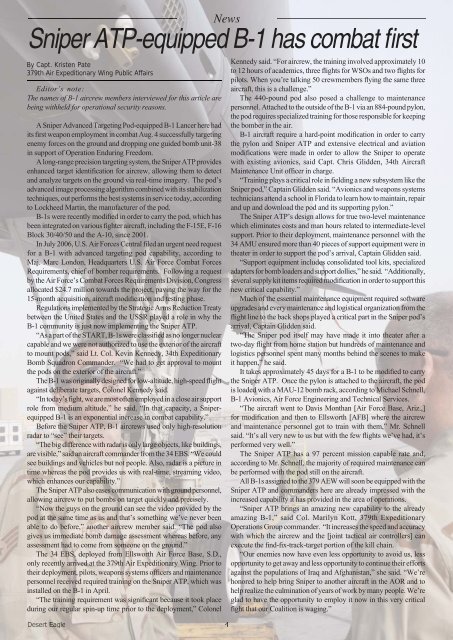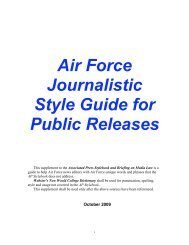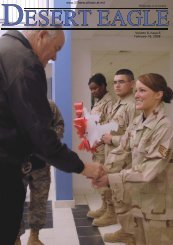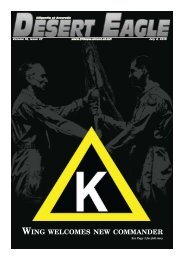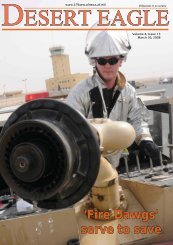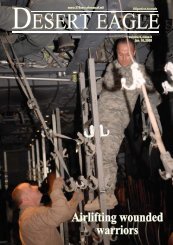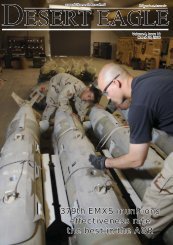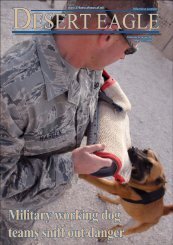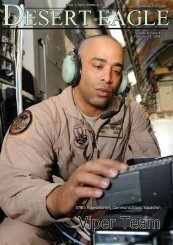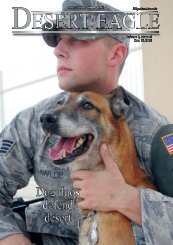Feature - 379th Air Expeditionary Wing
Feature - 379th Air Expeditionary Wing
Feature - 379th Air Expeditionary Wing
Create successful ePaper yourself
Turn your PDF publications into a flip-book with our unique Google optimized e-Paper software.
Desert Eagle<br />
News<br />
Sniper ATP-equipped B-1 has combat fi rst<br />
By Capt. Kristen Pate<br />
<strong>379th</strong> <strong>Air</strong> <strong>Expeditionary</strong> <strong>Wing</strong> Public Affairs<br />
Editor’s note:<br />
The names of B-1 aircrew members interviewed for this article are<br />
being withheld for operational security reasons.<br />
A Sniper Advanced Targeting Pod-equipped B-1 Lancer here had<br />
its fi rst weapon employment in combat Aug. 4 successfully targeting<br />
enemy forces on the ground and dropping one guided bomb unit-38<br />
in support of Operation Enduring Freedom.<br />
A long-range precision targeting system, the Sniper ATP provides<br />
enhanced target identifi cation for aircrew, allowing them to detect<br />
and analyze targets on the ground via real-time imagery. The pod’s<br />
advanced image processing algorithm combined with its stabilization<br />
techniques, out performs the best systems in service today, according<br />
to Lockheed Martin, the manufacturer of the pod.<br />
B-1s were recently modifi ed in order to carry the pod, which has<br />
been integrated on various fi ghter aircraft, including the F-15E, F-16<br />
Block 30/40/50 and the A-10, since 2001.<br />
In July 2006, U.S. <strong>Air</strong> Forces Central fi led an urgent need request<br />
for a B-1 with advanced targeting pod capability, according to<br />
Maj. Marc London, Headquarters U.S. <strong>Air</strong> Force Combat Forces<br />
Requirements, chief of bomber requirements. Following a request<br />
by the <strong>Air</strong> Force’s Combat Forces Requirements Division, Congress<br />
allocated $24.7 million towards the project, paving the way for the<br />
15-month acquisition, aircraft modifi cation and testing phase.<br />
Regulations implemented by the Strategic Arms Reduction Treaty<br />
between the United States and the USSR played a role in why the<br />
B-1 community is just now implementing the Sniper ATP.<br />
“As a part of the START, B-1s were classifi ed as no longer nuclear<br />
capable and we were not authorized to use the exterior of the aircraft<br />
to mount pods,” said Lt. Col. Kevin Kennedy, 34th <strong>Expeditionary</strong><br />
Bomb Squadron Commander. “We had to get approval to mount<br />
the pods on the exterior of the aircraft.”<br />
The B-1 was originally designed for low-altitude, high-speed fl ight<br />
against deliberate targets, Colonel Kennedy said.<br />
“In today’s fi ght, we are most often employed in a close air support<br />
role from medium altitude,” he said. “In that capacity, a Sniperequipped<br />
B-1 is an exponential increase in combat capability.”<br />
Before the Sniper ATP, B-1 aircrews used only high-resolution<br />
radar to “see” their targets.<br />
“The big difference with radar is only large objects, like buildings,<br />
are visible,” said an aircraft commander from the 34 EBS. “We could<br />
see buildings and vehicles but not people. Also, radar is a picture in<br />
time whereas the pod provides us with real-time, streaming video,<br />
which enhances our capability.”<br />
The Sniper ATP also eases communication with ground personnel,<br />
allowing aircrew to put bombs on target quickly and precisely.<br />
“Now the guys on the ground can see the video provided by the<br />
pod at the same time as us and that’s something we’ve never been<br />
able to do before,” another aircrew member said. “The pod also<br />
gives us immediate bomb damage assessment whereas before, any<br />
assessment had to come from someone on the ground.”<br />
The 34 EBS, deployed from Ellsworth <strong>Air</strong> Force Base, S.D.,<br />
only recently arrived at the <strong>379th</strong> <strong>Air</strong> <strong>Expeditionary</strong> <strong>Wing</strong>. Prior to<br />
their deployment, pilots, weapons systems offi cers and maintenance<br />
personnel received required training on the Sniper ATP, which was<br />
installed on the B-1 in April.<br />
“The training requirement was signifi cant because it took place<br />
during our regular spin-up time prior to the deployment,” Colonel<br />
4<br />
Kennedy said. “For aircrew, the training involved approximately 10<br />
to 12 hours of academics, three fl ights for WSOs and two fl ights for<br />
pilots. When you’re talking 50 crewmembers fl ying the same three<br />
aircraft, this is a challenge.”<br />
The 440-pound pod also posed a challenge to maintenance<br />
personnel. Attached to the outside of the B-1 via an 884-pound pylon,<br />
the pod requires specialized training for those responsible for keeping<br />
the bomber in the air.<br />
B-1 aircraft require a hard-point modifi cation in order to carry<br />
the pylon and Sniper ATP and extensive electrical and aviation<br />
modifi cations were made in order to allow the Sniper to operate<br />
with existing avionics, said Capt. Chris Glidden, 34th <strong>Air</strong>craft<br />
Maintenance Unit offi cer in charge.<br />
“Training plays a critical role in fi elding a new subsystem like the<br />
Sniper pod,” Captain Glidden said. “Avionics and weapons systems<br />
technicians attend a school in Florida to learn how to maintain, repair<br />
and up and download the pod and its supporting pylon.”<br />
The Sniper ATP’s design allows for true two-level maintenance<br />
which eliminates costs and man hours related to intermediate-level<br />
support. Prior to their deployment, maintenance personnel with the<br />
34 AMU ensured more than 40 pieces of support equipment were in<br />
theater in order to support the pod’s arrival, Captain Glidden said.<br />
“Support equipment includes consolidated tool kits, specialized<br />
adapters for bomb loaders and support dollies,” he said. “Additionally,<br />
several supply kit items required modifi cation in order to support this<br />
new critical capability.”<br />
Much of the essential maintenance equipment required software<br />
upgrades and every maintenance and logistical organization from the<br />
fl ight line to the back shops played a critical part in the Sniper pod’s<br />
arrival, Captain Glidden said.<br />
“The Sniper pod itself may have made it into theater after a<br />
two-day fl ight from home station but hundreds of maintenance and<br />
logistics personnel spent many months behind the scenes to make<br />
it happen,” he said.<br />
It takes approximately 45 days for a B-1 to be modifi ed to carry<br />
the Sniper ATP. Once the pylon is attached to the aircraft, the pod<br />
is loaded with a MAU-12 bomb rack, according to Michael Schnell,<br />
B-1 Avionics, <strong>Air</strong> Force Engineering and Technical Services.<br />
“The aircraft went to Davis Monthan [<strong>Air</strong> Force Base, Ariz.,]<br />
for modifi cation and then to Ellsworth [AFB] where the aircrew<br />
and maintenance personnel got to train with them,” Mr. Schnell<br />
said. “It’s all very new to us but with the few fl ights we’ve had, it’s<br />
performed very well.”<br />
The Sniper ATP has a 97 percent mission capable rate and,<br />
according to Mr. Schnell, the majority of required maintenance can<br />
be performed with the pod still on the aircraft.<br />
All B-1s assigned to the 379 AEW will soon be equipped with the<br />
Sniper ATP and commanders here are already impressed with the<br />
increased capability it has provided in the area of operations.<br />
“Sniper ATP brings an amazing new capability to the already<br />
amazing B-1,” said Col. Marilyn Kott, <strong>379th</strong> <strong>Expeditionary</strong><br />
Operations Group commander. “It increases the speed and accuracy<br />
with which the aircrew and the [joint tactical air controllers] can<br />
execute the fi nd-fi x-track-target portion of the kill chain.<br />
“Our enemies now have even less opportunity to avoid us, less<br />
opportunity to get away and less opportunity to continue their efforts<br />
against the populations of Iraq and Afghanistan,” she said. “We’re<br />
honored to help bring Sniper to another aircraft in the AOR and to<br />
help realize the culmination of years of work by many people. We’re<br />
glad to have the opportunity to employ it now in this very critical<br />
fi ght that our Coalition is waging.”


